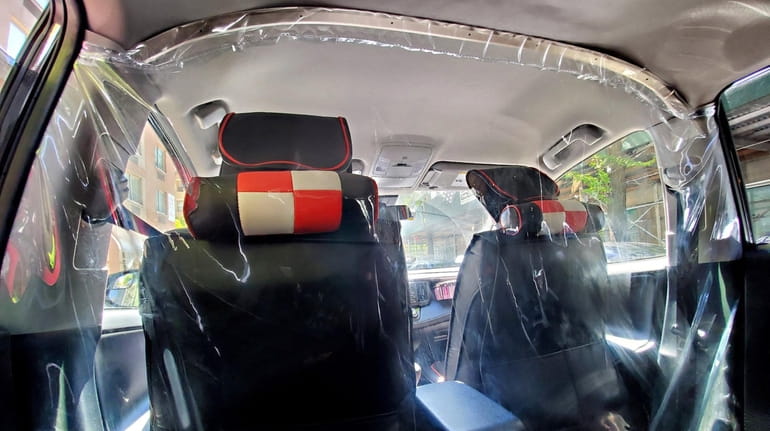Ride-hailing services changing amid pandemic

A view of a plastic lining separating the Uber driver and customer during the coronavirus pandemic on May 14 in Manhattan. Credit: Getty Images / Cindy Ord
A mandatory mask selfie uploaded to Uber is the new normal for drivers starting a shift during the coronavirus pandemic.
Drivers pack extra masks for unmasked passengers — and may refuse service to anyone who won’t cover up. And recalcitrance can be noted by the driver in the app, which can lead to passengers being suspended from hailing an Uber ride.
A decade ago, ride-hailing apps like Uber and Lyft began disrupting the traditional taxicab business. In 2020, the coronavirus pandemic is disrupting ride-hailing, the service centered on strangers in their personal vehicles chauffeuring other strangers for money.
“It’s unfortunate that you have to be on pins and needles in your own car. And carry Lysol in your own car. And wipes in your own car,” said Long Island Uber driver Roshon Martin, 49, of Rosedale, Queens, who stores the extra masks in a resealable plastic bag in his 2017 Honda’s glove compartment.
On Long Island and beyond, the pandemic has changed not only the passenger experience but how many people use the services.
Uber’s ride-hailing business fell 80% during the pandemic, the company’s chief executive, Dara Khosrowshahi, said in a call last month with investors. “I won’t sugarcoat it,” he said.
“COVID-19 has had a dramatic impact on rides, with the business down about 80 percent globally,” he said.
Uber spokesman Harry Hartfield said the company imposed its face-covering requirement on May 18.
Early on in the pandemic, back when coronavirus infections were rare enough that the city disclosed them individually, an Uber driver who works on Long Island was reported to be infected in March. Soon after news of the driver’s infection, the city’s caseload became so exponentially enormous that tracing each person’s contacts became futile.
Sarah M. Kaufman, associate director at New York University’s Rudin Center for Transportation Policy & Management, said that, due to the pandemic and its fallout, there will likely continue to be a reduction in the number of trips in Ubers and Lyfts and traditional taxicabs — even as the region begins to reopen.
That’s because there’s less going on, fewer businesses open and people have lost their jobs.
Still, amid the reopening, juiced by jitters over riding mass transit, the rate of commuters using app-hail services is expected to be higher than before the lockdown, she said. Even a minor increase in their use could jam traffic in Manhattan, Kaufman said, even if the overall number of people commuting is lower than before the pandemic.
“There is a chance that we’re going to hit just complete gridlock based on the number of people using personal cars and then the rides being hailed either by taxi or by app-hail vehicles,” she said Friday in an interview, adding: “The road geometry cannot absorb that many more.”
Even 10% more people using vehicles commuting into Manhattan could cause gridlock, she said.
Another issue: so-called dead-head return trips.
A ride-hail driver who takes a passenger from Long Island into the city is legally prohibited from picking up another until the driver returns to the Island. That means empty vehicles on the road in the city, in traffic, heading back east.
“Having vehicles roam around with no passengers is absolutely inefficient for how the city moves and wasting gas and creating air pollution,” she said.
No matter where they ride in the region, both Uber and Lyft passengers must comply with the new precautions, with the Lyft app mandating passengers certify their compliance before being allowed to hail a ride.
The rules come on top of New York City’s mid-March prohibition on pooled trips, where riders potentially prolonged their trip by sharing the ride with strangers. That option is no longer available on apps, erasing a possible avenue of savings.
Neither Nassau nor Suffolk county directly regulates services like Uber or Lyft, and the state doesn’t track the numbers of rides or drivers, according to state Department of Motor Vehicles spokeswoman Lisa Koumjian.
Koumjian said: “All New Yorkers are required to wear masks in public when social distancing is not possible. Any additional requirements are at the company’s discretion to implement.”
Around the world, different jurisdictions have promulgated various rules in ride-hailing to halt the virus’ spread. In Australia, for example, the government is telling passengers to handle their own luggage, be sure to ride in the back seat, and not open the door themselves, according to the Australian Financial Review, which said the government mandated that air conditioning be set not to recirculate air, or else windows should be kept open.
Rosalie Drago, Suffolk’s commissioner of labor, licensing and consumer affairs, said the county is studying how the pandemic, and the recovery, might affect the economy, ride-hailing and the intersections between the two.
Among the questions being considered by policymakers: how will app-hailing be impacted by changes in last-mile transport — transportation lingo for travel to and from a hub to a final destination — the re-openings and closures of restaurants or bars, and how many people might use app-based or tech policy to get to or from work, instead of mass transit.
“It’s going to be slow. It’s going to be cautious and it’s going to evolve over time,” Drago said, adding: “Depending on the behavior of the public and what people are comfortable with, the agility that the technology might afford might give them an advantage at this point but it’s not clear.”
Dena Martin of Seaford, a city math teacher, said she rode in an Uber before the pandemic but doesn’t feel comfortable riding in one now.
“I feel that we know what to do to protect ourselves, but the unknown of the driver and his contacts” concerns her.
“Bottom line, drivers need to work to support their families, are they going to take the proper precautions of staying home when sick? Are other riders going to do the same? I think the things that are out of our control scare us the most.”

